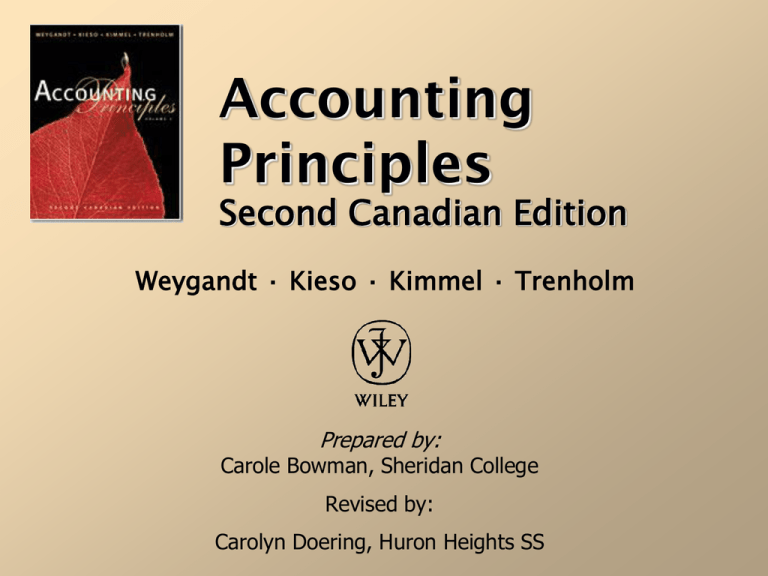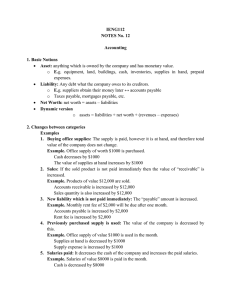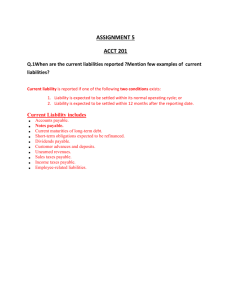
Accounting
Principles
Second Canadian Edition
Weygandt · Kieso · Kimmel · Trenholm
Prepared by:
Carole Bowman, Sheridan College
Revised by:
Carolyn Doering, Huron Heights SS
CHAPTER
11
CURRENT LIABILITIES
ACCOUNTING FOR
CURRENT LIABILITIES
A current liability is a debt that can
reasonably be expected to be paid
1. from existing current assets or
in the creation of other
current liabilities and
2. within one year or the
operating cycle, whichever
is longer.
ACCOUNTING FOR CURRENT
LIABILITIES
Types of liabilities
1)
2)
3)
Definitely determinable (known
amount, payee, and due date)
Estimated (estimate the amount or
timing)
Contingent (potential liabilities that
depend on a future event such as a
pending lawsuit)
ACCOUNTING FOR
CURRENT LIABILITIES
Definitely determinable current
liabilities include:
1. Operating line of credit
2. Accounts and notes payable
3. Sales tax payable
4. Payroll and employee benefits
5. Unearned revenues
6. Current maturities of
long-term debt
OPERATING LINE OF CREDIT
A pre-authorized demand loan, allowing the
company to write cheques up to a preset limit
when needed.
Helps manage temporary cash shortfalls
Security called collateral is required (usually a
companies assets)
Disclosed by footnote and by reporting
any resulting bank overdraft as a current
liability.
NOTES PAYABLE
Notes
Payable are obligations in the form of
written promissory notes that usually require
the borrower to pay interest.
Notes payable may be used instead of accounts
payable because it supplies documentation of the
obligation in case legal remedies are needed to
collect the debt.
Notes due for payment within one year
of the balance sheet date are usually
classified as current liabilities.
NOTES PAYABLE EXAMPLE
Company B agrees to lend $100,000 to us on March 1 for 4 month note
payable at 6% interest (adjusting entries are completed each quarter)
Mar 1 Cash
100,000
Note Payable
100,000
To record issue of note payable
Mar 31 Interest Expense
500
Interest Payable
500
To record interest for one month (end of the accounting quarter)
June 30 Interest Expense
1,500
Interest Payable
1,500
To accrue interest for April, May and June (end of the quarter)
July 1 Note Payable
Interest Payable
100,000
2,000
Cash
102,000
To record payment to Company B and accrued interest
SALES TAXES PAYABLE
Sales tax is expressed as a stated percentage of
the sales price of goods sold to customers by a
retailer.
Sales tax includes the goods and service tax
(GST), provincial sales tax (PST) or harmonized
sales taxes (GST and PST combined).
The retailer (or selling company) collects the tax
from the customer when the sale occurs,
and periodically (usually monthly)
remits the collections to the government.
PAYROLL AND EMPLOYEE BENEFITS
Salaries or wages payable represent the
amounts owed to employees for a pay period.
Payroll withholdings include federal and
provincial income taxes, Canada Pension Plan
(CPP) contributions, and employment
insurance (EI) premiums.
Employees may also voluntarily authorize
withholdings for charity, retirement, medical,
or other purposes.
Payroll withholdings are remitted to
governmental taxing authorities.
PAYROLL EXAMPLE
Mar 7 Salaries and Wages Expense
100,000
CPP Payable
3,870
EI Payable
2,250
Income Taxes Payable
30,000
United Way Payable
2,445
Union Dues Payable
1,435
Salaries and Wages Payable60,000
To record payroll and deductions
There would be other JE’s to record:
the actual payment to employees
the employers share of payroll costs-EI, CPP, WSIB
to remit the payables
UNEARNED REVENUES
Unearned Revenues (advances from customers)
occur when a company receives cash before a
service is rendered.
Examples are when an airline sells a ticket for
future flights or when a lawyer receives legal fees
before work is done.
Sept 6 Cash
200,000
Unearned Hockey Ticket Revenue 200,000
To record sale of 1,000 season tickets
Sept 25 Unearned Hockey Ticket Revenue 8,000
Hockey Ticket Revenue
8,000
To record hockey ticket revenue earned
CURRENT MATURITIES OF
LONG-TERM DEBT
Another item classified as a current liability is current
maturities of long-term debt.
For example, part of a 5 year note payable must be paid
each year. The amount due that year should be
recorded as a current liability.
Current maturities of long-term debt are often identified
on the balance sheet as long-term debt due within one
year.
ESTIMATED LIABILTIES
Obligation that exists but for which the
amount and timing is uncertain.
However, the company can reasonably
estimate the liability.
Examples include property taxes and
warranty liabilities (to be discussed).
Other examples include vacation pay and
pensions.
PROPERTY TAXES
Property taxes are accrued monthly
based on the prior year’s tax bill.
When the property tax bill for the
current year is received, the company will
adjust its monthly expense for the
remainder of the year.
PROPERTY TAX EXAMPLE
Tantramar Inc. had property tax of $5520 last year. For January and February of
this year they do not know what the tax will be, so their calculation is based on last
year’s assessment (ie. an estimated liablity)
Jan 31
Property Tax Expense (5520/12)
Property Tax Payable
To accrue property tax payable (same for Feb.)
460
460
The assessment arrives in March for $6000, payable on May 31
Mar 31
May 31
June 30
Property Tax Expense (6000-920)/10
Property Tax Payable
To accrue property tax payable (repeat for April)
Property Tax Payable (460x2 +508x2)
Property Tax Expense
Prepaid Property Tax (508x7)
Cash
To pay property tax
508
508
1,936
508
3,556
6,000
Property Tax Expense
508
Prepaid Property Tax
508
To record property tax expense (repeat at the end of July to December)
PRODUCT WARRANTIES
Warranty contracts may lead to future
costs for replacement or repair of
defective units.
Using prior experience with the product,
the company estimates what the cost of
servicing the warranty will be.
Estimated warranty costs are accrued
with a debit to warranty expense and a
credit to estimated warranty liability.
CONTINGENT LIABILITIES
Contingent liabilities exist when there is
uncertainty about the outcome.
Contingencies are accrued by a debit to an
expense account and a credit to a liability
account if both of the following conditions are
met:
1. The contingency is likely, and
2. The amount of the contingency can be
reasonably estimated.
They should be disclosed in the notes to the
financial statements.
FINANCIAL STATEMENT
PRESENTATION
Each major type of current liability is listed
separately.
Often list bank loans, notes payable, and
accounts payable first, then other liabilities.
COMINCO LTD.
Current liabilities (Millions)
Bank loans and notes payable
Accounts payable and accrued liabilities
Income and resource taxes
Long-term debt due within one year
$ 5
230
36
30
$301
COPYRIGHT
Copyright © 2002 John Wiley & Sons Canada, Ltd. All rights reserved.
Reproduction or translation of this work beyond that permitted by
CANCOPY (Canadian Reprography Collective) is unlawful. Request for
further information should be addressed to the Permissions Department,
John Wiley & Sons Canada, Ltd. The purchaser may make back-up copies
for his / her own use only and not for distribution or resale. The author and
the publisher assume no responsibility for errors, omissions, or damages,
caused by the use of these programs or from the use of the information
contained herein.








